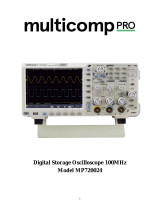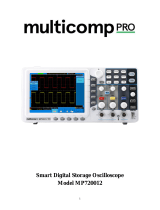
Table of C onten ts
1 . S a fe ty Inform ation ····················································································1
2. H ow to Im plem en t the G en eral Ins pection ···········································4
3. H o w to U se the O s cillo sc op e ································································· 5
Power the Oscilloscope ··························································································· 5
The Structure of the Oscilloscope ··············································································5
Front Panel and Keys ······························································································5
Side Panel ·············································································································8
Introduction to the User Interface of the Oscilloscope ··················································· 9
Functional Check ····································································································9
Probe Compensation ····························································································· 11
Probe Attenuation Coefficient Setting ······································································· 12
Safe Use of Probe ·································································································13
Vertical System ·····································································································14
Horizontal System ·································································································15
Measuring System ································································································ 16
4. H o w to U se the M u ltim e te r ····································································22
About This Chapter ······························································································· 22
Instrument Interface ······························································································ 22
5. H o w to U se th e W ave fo rm G en era to r (o ptio na l) ······························· 2 5
C o nn ec t th e ou tp ut ································································································· 25
S e t th e w av e fo rm ····································································································25
Set the load ··········································································································25
Output the sine waveform ·······················································································26
Output the square waveform ···················································································27
Output the ramp waveform ····················································································· 27
Output the pulse waveform ·····················································································27
Output the Arbitrary waveform ·················································································28
6. C om m u nica tion w ith P C ········································································29
7. Tro ublesho o ting ····················································································· 30
8 . Tech nic al S p ec ific atio ns ······································································· 31
Oscilloscope ·········································································································31
Multimeter ············································································································33
Arbitrary Waveform Generator (Optional) ·································································· 34
General Technical Specifications ············································································· 36
9 . A p p e nd ix ··································································································37
Appendix A: List of Accessories ···············································································37
Appendix B: Maintenance and Cleaning ··································································· 37
Appendix C: Fuse Replacement ·············································································· 40



























